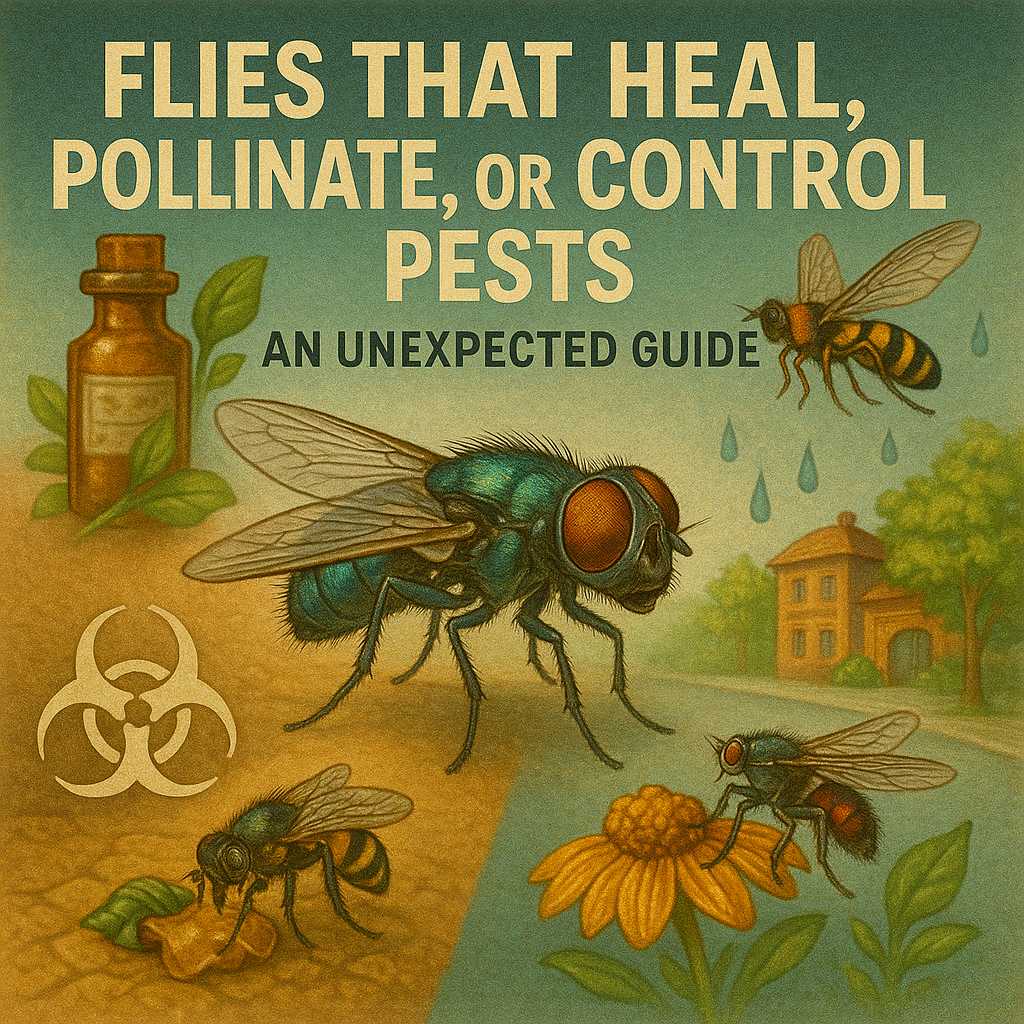
Unique Behaviors and Astonishing Roles in the Ecosystem
Flies are undoubtedly one of the most misunderstood groups of insects. Commonly associated with garbage, disease, and annoyance, they are rarely appreciated for their incredible species diversity, adaptations, and ecological functions.
In this article, we explore some of the most curious and ecologically valuable species of the order Diptera, revealing that not all flies are pests—some are true allies of ecosystems… and others, simply extraordinary.
🌺 Pollinator Flies: The Unexpected Bees
Although pollination is typically attributed to bees and butterflies, many fly species fulfill this role efficiently and quietly.
🔹 Eristalis tenax (drone fly)
This species is so similar to a bee that it often goes unnoticed. But this isn’t just for show: its Batesian mimicry (looking like a dangerous insect without being one) protects it from predators.
As it visits flowers to feed on nectar, it carries pollen and plays a key role in the pollination of crops and wild plants.
🔹 Syrphidae flies
Also known as “flower flies,” some adult species feed exclusively on nectar. In contrast, their larvae usually prey on aphids, making them natural biological controllers.
💀 Necrophagous Flies: The Ecosystem Recyclers
🔹 Lucilia sericata (green bottle fly)
Commonly seen on carcasses or decaying meat, this species plays a crucial role: speeding up decomposition and nutrient recycling in ecosystems.
Its larvae also have a surprising medical use: in maggot therapy, they are employed to clean dead tissue in chronic wounds, thanks to their ability to feed only on necrotic tissue without harming healthy cells.
🔹 Calliphora vicina (blue bottle fly)
One of the most important species in forensic entomology. Its presence and development on corpses help estimate the time of death in criminal investigations. Its life cycle is so well studied that it serves as a “biological clock” for forensic experts.
🕷️ Parasitoid Flies: Nature’s Pest Controllers
🔹 Tachinidae family
This group includes hundreds of parasitoid fly species that lay their eggs on or inside other insects. When the larvae hatch, they feed on the host until it dies.
They are used in agriculture as biological pest control agents against caterpillars, beetles, or stink bugs, reducing the need for pesticides.
Some species even have surgical precision, detecting chemical signals from their prey from several meters away.
🧬 Flies with Unique and Unexpected Behaviors
🔹 Ferdinandea cuprea: the sun-loving fly
Though it looks like a bee due to its coloration, this fly exhibits a unique behavior: it rests on warm tree trunks to absorb solar energy, a rare habit among dipterans. It is usually found in temperate forests and acts as an occasional pollinator.
🔹 Gasterophilus intestinalis (horse stomach botfly)
Lays its eggs on horses’ coats. When the animal licks itself, the larvae enter the mouth and migrate to the stomach, where they complete their development. It is an extremely specialized parasite, with a life cycle perfectly synchronized with the host’s behavior.
🔹 Celyphidae: the “beetle flies”
These small Southeast Asian flies have a hard, shiny dorsal structure resembling a beetle’s elytra. They are a spectacular example of evolutionary convergence, and their unusual appearance has made them a subject of morphological study.
🌎 Flies in Balance: Ecological Role and Biodiversity
Beyond the extraordinary, many flies play vital roles in ecological balance:
-
Decomposers of organic matter
-
Food source for birds, reptiles, and other insects
-
Biological indicators of pollution or environmental health
-
Secondary pollinators, especially in cold climates or high altitudes where bees are scarce
In urban, rural, and natural ecosystems, flies are not intruders—they are key players in recycling and biological stability.
✅ A Vision of Respect for Biodiversity
At Eco Fauna Control, we understand that not all flies are pests. That’s why we apply a professional and ecological approach that distinguishes between nuisance and beneficial species.
Our solutions include:
🔬 Precise diagnostics: We identify the species and their behavior to determine if intervention is necessary.
🌱 Selective control: We act only on species that pose a risk to human health or the environment.
🧪 Sustainable technologies: We minimize chemical use and promote biological and physical strategies.
📚 Environmental education: We inform our clients about the importance of beneficial species and how to protect them.
Because a good pest control strategy doesn’t aim to eliminate everything that flies—it seeks to preserve what is useful and mitigate what poses a risk.
Not all flies are the same. Some pollinate, others control pests, recycle waste, or even help in medicine. There are even species with behaviors so surprising, they seem straight out of a science fiction movie.
Understanding this diversity allows us to appreciate their ecological value and act wisely. At Eco Fauna Control, we advocate for responsible management that respects biodiversity and protects human health.
If you’d like expert advice on fly control or to learn more about our sustainable strategies, contact us today.
